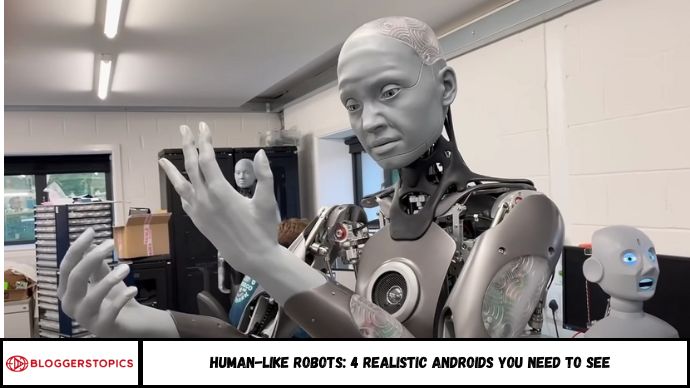What if you couldn’t tell the difference between a human and a robot?
That’s no longer science fiction it’s a reality that’s rapidly unfolding. Today’s most advanced androids are capable of facial expressions, realistic body movements, and even conversation that mimics emotion.
Human-like robots are entering industries from healthcare to education, reshaping how we interact with machines. In this article, we’ll explore four cutting-edge robots that look and behave like people, and examine the real-world roles they’re playing right now.
Human-like robots, also known as androids, are transforming human-technology interaction. This article introduces four of the most realistic androids created to date. These lifelike robots are used in healthcare, education, AI testing, and entertainment, offering a glimpse into the future of robotics and human-machine collaboration.
For decades, robots that look like humans have captured our imagination—first in science fiction, and now increasingly in real life. From the haunting replicants of Blade Runner to Ava’s unsettling charm in Ex Machina, these lifelike creations offer a lens through which we examine identity, consciousness, and the blurred line between human and machine.
What was once fantasy is edging closer to reality. Roboticists have spent nearly a century trying to build machines that don’t just function like humans—but look and feel human, too. While there’s still something unsettling about ultra-realistic androids (a phenomenon known as the uncanny valley), research continues to reveal their real-world value. In fact, a 2022 study in the journal Children found that humanoid robots can help children with autism develop essential social skills.
They may not be fully indistinguishable from humans—yet—but these robots are getting remarkably close. Here are four of the most advanced human-like robots in existence today.
What Are Human-Like Robots?
Human-like robots or androids are machines designed to replicate the appearance, movements, and sometimes even the personality traits of humans. These robots combine artificial intelligence (AI), robotics, and synthetic materials like artificial skin to simulate human interaction.
They’re used across a variety of sectors:
- Customer service
- Elder care
- Public speaking and education
- AI and human behavior research
- Film and media
By imitating human behavior, these robots aim to make machine interaction more natural and intuitive.
1. Sophia – The Celebrity Android
Sophia, developed by Hanson Robotics in Hong Kong, is perhaps the most famous humanoid robot in existence. She’s known worldwide for her media appearances and even holds a symbolic Saudi Arabian citizenship.
Key Features:
- Facial recognition and simulated emotional responses
- Natural language processing for conversation
- Media interviews and public speeches
Use case: Sophia is used primarily in public relations, education, and to demonstrate AI-human interaction potential.
2. Ameca – The Most Expressive Robot
Created by Engineered Arts in the UK, Ameca is known for having some of the most lifelike facial expressions ever seen in a robot.
Highlights:
- Extremely realistic facial gestures, including smiling and frowning
- AI integration for conversation and real-time interaction
- Modular design for easier upgrades and testing
Use case: Ameca is ideal for exhibitions, tech demos, and AI-human interaction studies.
3. Nadine – The Emotionally Intelligent Robot
Nadine was developed by Nanyang Technological University in Singapore. She’s modeled after her creator, Professor Nadia Thalmann, and is designed to appear emotionally responsive.
Capabilities:
- Recognizes individuals and remembers previous conversations
- Simulates emotions such as joy, anger, and sadness
- Maintains eye contact and mimics social behavior
Use case: Nadine has been used as a receptionist and is being tested in elderly care as a companion robot.
4. Geminoid DK – The Robotic Doppelgänger
Geminoid DK was developed by Hiroshi Ishiguro Laboratories in Japan and modeled after Danish professor Henrik Schärfe. It’s one of the most visually identical human-replica robots ever made.
Standout Features:
- Hyper-realistic appearance and matching voice
- Remote control through telepresence
- Fluid motion and realistic blinking
Use case: Primarily used in educational environments and presentations to explore the boundaries of presence and identity.
Why Are Human-Like Robots Important?
Human-like robots serve purposes far beyond novelty. Their appearance and behavior allow them to:
- Enhance comfort and engagement in human-machine interaction
- Simulate empathy and emotional support in healthcare and elder care
- Serve as platforms for AI development, testing, and education
- Act as virtual presenters or teachers in educational settings
Industry Insight:
According to Statista, the global humanoid robot market is expected to exceed $20.6 billion by 2030, driven by advancements in AI and increasing demand in healthcare, education, and service industries.
Frequently Asked Questions
1. What is a human-like robot?
A human-like robot, or android, is designed to resemble and behave like a human using advanced AI, sensors, and synthetic materials.
2. Can these robots feel emotions?
No. While they can simulate emotional responses, robots do not experience emotions the way humans do.
3. Are these robots being used today?
Yes. They are currently used in sectors like healthcare, education, public speaking, and customer service.
4. What is the most lifelike robot?
Ameca is considered one of the most expressive and physically realistic humanoid robots.
5. How much does a humanoid robot cost?
Prices vary widely, from around $100,000 to over $1 million, depending on features and complexity.
6. Will human-like robots replace humans in jobs?
They may assist or augment human roles but are unlikely to fully replace people due to limitations in empathy and judgment.
Conclusion
The line between humans and machines is becoming increasingly blurred. Robots like Sophia, Ameca, Nadine, and Geminoid DK demonstrate just how advanced and human-like robotics can be. While they may not yet possess true consciousness or emotion, their realism opens new possibilities—and raises new questions—about how we integrate AI into society.







